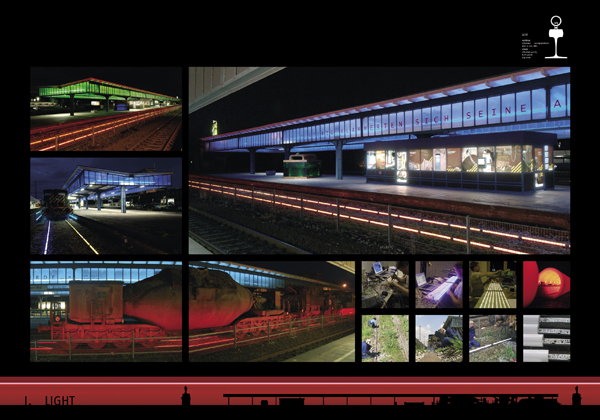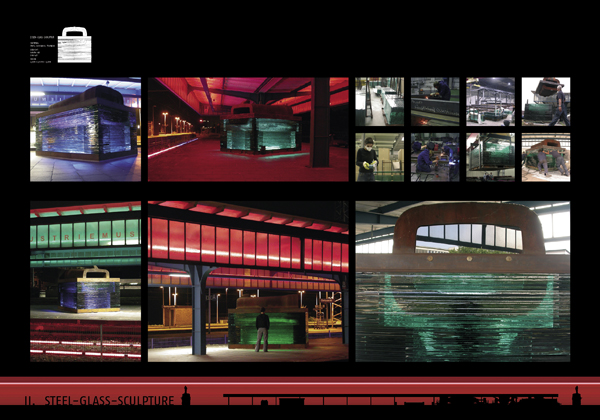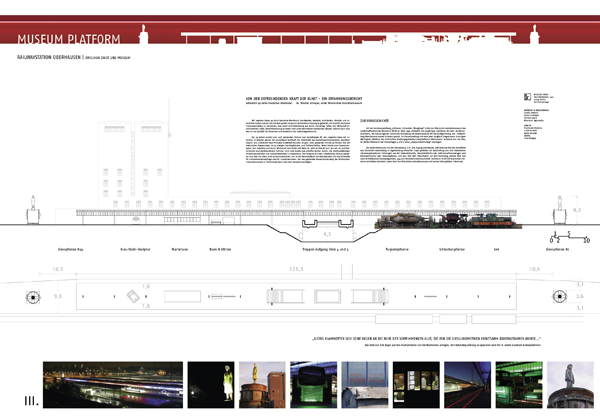
museum platform oberhausen by christoph stark from germany
designer's own words:
The museum platform at the central railway station in Oberhausen, Germany.
In the summer of 2005 the Industrial Museum of the Rhine Area (RIM) held an competition in order to raise the attractiveness of the “museum platform“ at the Oberhausen central Railway Station.
The intention was to integrate large-scale objects of the heavy industry into the layout of the platform with the aim to create a strong signatory design as well as to both raise the attention of the platform and to enhance the railway station's atmosphere as a whole.
The concept of the refurbishment was not to simply build another exhibiton facility, but to capture the roaming gaze of passing travellers. Our focus had been put on communication and attention-raising amongst the railway station's public.
Positioned on top of massive foundry laddles, bearing the marks of received chainsaw treatment are five metre high wood sculptures at each end of the museum platform.
In calmness and consummate ease they stand on top of those steel colossi, red in their natural beech colour.
At night they are illuminated, like profanised guardian angels, floating in an other-wordly fashion.
The guardian angels are like utopian carriers of hope toward a masterful structural change, by which the city of Oberhausen -as many other towns of the Ruhr area- is seized.
An additional, non-figurative sculpture plays with the material properties of steel and glass. A 15 tons weighing ingot mould -cautiously enclosed by a base of glass- emphasises the archaic enormousness of heavy industry which even in the 'digital age' earns its name.
The playful handling of the materials finds a punch line in this almost minimalist steel and glass sculpture where the heavy ingot mould tipped onto the horizontal seems to dip into a huge glass cube of more than 9m3 making it seem enclosed by an ice cube.
The cube -made of 19mm thick sheets of glass with an area of almost 300m2- shimmers in green and blue when a ray of sunlight catches it, or when at dusk it is lit internally. The greenish bluish effect contrasts with the rusted red of the steel container.
A surface area of around 80m2 comprising the waiting room walls, the train timetable and the destination panel is covered with graphics giving information on the museum locations and exhibited objects. The stairs are decorated with industrial designs which draw the attention of the passers-by up onto the platform.
The art work is used to underline the significance of the heavy industry for the rise of the railway and the former steel city that was Oberhausen. However, by no means does the design focus on nostalgia.
Whilst slim express trains on the opposite platform are waiting for their passengers or rush past under the high wooden sculptures, an LED lighting system keeps the entire museum platform area lit in a composition of changing colours.
The old train parked here will be driving on luminescent rail tracks once night has drawn in.
This is made possible by 33000 RGB strips on a length of 700m. The RGB strips, damage proof in white acrylic tubes, are fastened on the disused track in front of, behind and under the axes of the old trains and carriages and placed in the niches of the trains, in the roof of the platform, and inside the glass cube of the steel glass sculpture.
A RGB-LED controller enables the change of colour patterns of the lighting display. Every evening over there is a light show telling the story of the journeys on and of glowing metal tracks; the travelling, the speed, the arrivals and departures, passing and overtaking. The -sometimes fast- to and fro of the lights across the tracks using over thousands colour channels might in some of us evoke the virtual transport of information such as email which have replaced the carrying and towing of materials during the industrial age.
The judges -representatives of the regional landscape association and the city council of Oberhausen- unequivocally chose Atelier Stark's draft that aimed at establishing a symbiosis between traditional and modern means of artistic design.
The museum platform's opening was officially held in August, 2006. As an landscape installation it is now permanently walkable and viewable.
museum platform
 museum platform
museum platform
 museum platform
museum platform